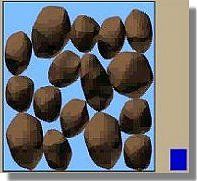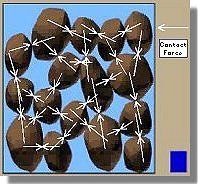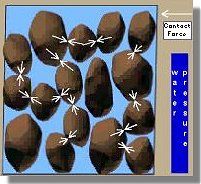|
|
|
Explanation
|
To understand liquefaction, it is important to recognize the conditions
that exist in a soil deposit before an earthquake. A soil deposit consists
of an assemblage of individual soil particles. If we look closely at
these particles, we can see that each particle is in contact with a
number of neighboring particles. The weight of the overlying soil
particles produce contact forces between the particles - these forces hold
individual particles in place and give the soil its strength.
|

Soil grains in a soil deposit. The height of the
blue column to the right represents the level of porewater pressure in the soil.
|

The length of the arrows represent the size
of the contact forces between individual soil grains. The contact forces are
large when the porewater pressure is low.
|
|
|
Liquefaction occurs when the structure of a loose,
saturated sand breaks down due to
some rapidly applied loading. As the structure breaks down, the loosely-packed
individual soil particles attempt to move into a denser configuration. In an
earthquake, however, there is not enough time for the water in the pores of the
soil to be squeezed out. Instead, the water is "trapped" and prevents the soil
particles from moving closer together. This is accompanied by an increase in water
pressure which reduces the contact forces between the individual soil particles,
thereby softening and weakening the soil deposit.
|
|
 Observe how small the contact forces are because
of the high water pressure. In an extreme case, the porewater pressure may become
so high that many of the soil particles lose contact with each other. In such cases,
the soil will have very little strength, and will behave more like a liquid than a
solid - hence, the name "liquefaction".
Observe how small the contact forces are because
of the high water pressure. In an extreme case, the porewater pressure may become
so high that many of the soil particles lose contact with each other. In such cases,
the soil will have very little strength, and will behave more like a liquid than a
solid - hence, the name "liquefaction".
|

|
|
|

